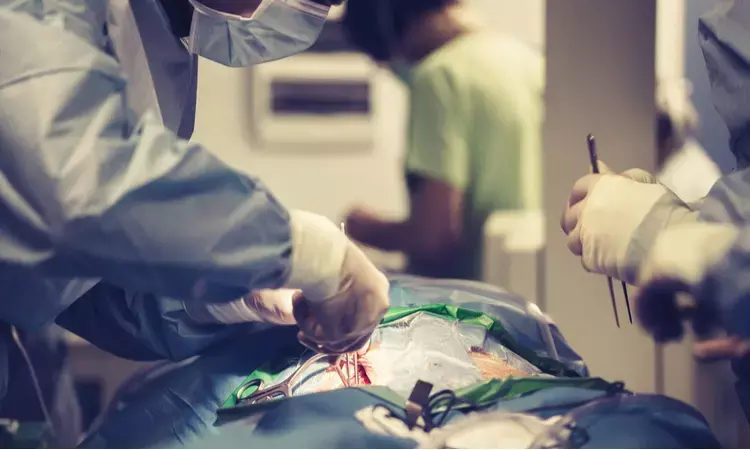- Home
- Medical news & Guidelines
- Anesthesiology
- Cardiology and CTVS
- Critical Care
- Dentistry
- Dermatology
- Diabetes and Endocrinology
- ENT
- Gastroenterology
- Medicine
- Nephrology
- Neurology
- Obstretics-Gynaecology
- Oncology
- Ophthalmology
- Orthopaedics
- Pediatrics-Neonatology
- Psychiatry
- Pulmonology
- Radiology
- Surgery
- Urology
- Laboratory Medicine
- Diet
- Nursing
- Paramedical
- Physiotherapy
- Health news
- Fact Check
- Bone Health Fact Check
- Brain Health Fact Check
- Cancer Related Fact Check
- Child Care Fact Check
- Dental and oral health fact check
- Diabetes and metabolic health fact check
- Diet and Nutrition Fact Check
- Eye and ENT Care Fact Check
- Fitness fact check
- Gut health fact check
- Heart health fact check
- Kidney health fact check
- Medical education fact check
- Men's health fact check
- Respiratory fact check
- Skin and hair care fact check
- Vaccine and Immunization fact check
- Women's health fact check
- AYUSH
- State News
- Andaman and Nicobar Islands
- Andhra Pradesh
- Arunachal Pradesh
- Assam
- Bihar
- Chandigarh
- Chattisgarh
- Dadra and Nagar Haveli
- Daman and Diu
- Delhi
- Goa
- Gujarat
- Haryana
- Himachal Pradesh
- Jammu & Kashmir
- Jharkhand
- Karnataka
- Kerala
- Ladakh
- Lakshadweep
- Madhya Pradesh
- Maharashtra
- Manipur
- Meghalaya
- Mizoram
- Nagaland
- Odisha
- Puducherry
- Punjab
- Rajasthan
- Sikkim
- Tamil Nadu
- Telangana
- Tripura
- Uttar Pradesh
- Uttrakhand
- West Bengal
- Medical Education
- Industry
Routine use of cerebral emboli prevention devices during TAVI fails to reduce stroke incidence: NEJM

A new study published in The New England Journal of Medicine showed that stroke was not prevented by routinely using devices to avoid cerebral emboli during transcatheter aortic valve implantation (TAVI).
TAVI is an emerging therapy option for low-risk surgical patients and the preferred technique for aortic valve replacement (AVR) in patients with symptomatic severe aortic stenosis (AS) who are at high risk for surgical AVR. Because of periprocedural embolization, stroke rates in TAVI are between 1.2 and 6.7%, and they usually happen in the first few days following the surgery.
Disabling stroke during TAVI is still a fatal consequence that has a high rate of morbidity and death. After TAVI, silent stroke has been seen on diffusion-weighted magnetic resonance imaging (DW-MRI), in addition to symptomatic strokes. The combination between transcatheter valves and the apparatus required for installation is a possible nidus for embolizing debris leading to stroke. However, the etiology of stroke during TAVI is probably multifaceted. So, Rajesh Kharbanda and colleagues wanted to evaluate the function of cerebral embolic protection (CEP) devices, which may lower the risk of stroke by preventing embolization in the cerebral circulation.
This randomized, controlled experiment was carried out at 33 UK institutions. TAVI with a CEP device (CEP group) or TAVI without a CEP device (control group) were administered to 7,635 aortic stenosis patients in a 1:1 random assignment. Stroke within 72 hours of TAVI or prior to hospital discharge (if discharged earlier) was the main outcome.
The CEP group consisted of 3,815 people, whereas the control group had 3820. Nearly, 81 out of 3,795 individuals (2.1%) in the CEP group and 82 out of 3,799 participants (2.2%) in the control group experienced a primary-outcome incident (difference, −0.02 percentage points; 95% CI, –0.68 to 0.63; P=0.94). 53 individuals (1.4%) in the control group and 47 individuals (1.2%) in the CEP group suffered a disabling stroke.
In the CEP group, 29 people (0.8%) died, whereas in the control group, 26 persons (0.7%) died. The 2 groups' overall rates of access-site problems seemed to be comparable (8.1% in the CEP group and 7.7% in the control group). 13 of the 3,803 individuals (0.3%) in the control group experienced 13 significant adverse events, whereas 22 of the 3798 participants (0.6%) experienced 24 serious adverse events. Overall, routine use of CEP did not reduce the risk of stroke within 72 hours among subjects having TAVI.
Source:
Kharbanda, R. K., Kennedy, J., Jamal, Z., Dodd, M., Evans, R., Bal, K. K., Perkins, A. D., Blackman, D. J., Hildick-Smith, D., Banning, A. P., Baumbach, A., Ludman, P., Palmer, S., Stables, R. H., Henderson, R., Appleby, C., Cotton, J., Curzen, N., Ozkor, M., … BHF PROTECT-TAVI Investigators. (2025). Routine cerebral embolic protection during transcatheter aortic-valve implantation. The New England Journal of Medicine. https://doi.org/10.1056/NEJMoa2415120
Neuroscience Masters graduate
Jacinthlyn Sylvia, a Neuroscience Master's graduate from Chennai has worked extensively in deciphering the neurobiology of cognition and motor control in aging. She also has spread-out exposure to Neurosurgery from her Bachelor’s. She is currently involved in active Neuro-Oncology research. She is an upcoming neuroscientist with a fiery passion for writing. Her news cover at Medical Dialogues feature recent discoveries and updates from the healthcare and biomedical research fields. She can be reached at editorial@medicaldialogues.in
Dr Kamal Kant Kohli-MBBS, DTCD- a chest specialist with more than 30 years of practice and a flair for writing clinical articles, Dr Kamal Kant Kohli joined Medical Dialogues as a Chief Editor of Medical News. Besides writing articles, as an editor, he proofreads and verifies all the medical content published on Medical Dialogues including those coming from journals, studies,medical conferences,guidelines etc. Email: drkohli@medicaldialogues.in. Contact no. 011-43720751


